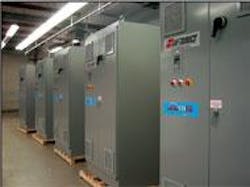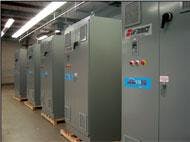Harmonic Distortion can be Elusive Cause of Power Problems
If your plant is experiencing inexplicable nuisance tripping, inconsistent power quality or extensive power interruptions, harmonic distortion may be the culprit.
Water treatment plants and pumping stations supported by variable-frequency drives (VFDs) may be unwittingly threatened with power system problems including interruptions, interference, downtime, and even disruption of instrumentation and other sensitive equipment due to an elusive culprit called harmonic distortion, an undetected condition which has been said to cost billions of dollars in annual losses due to downtime, equipment failures and malfunctioning systems.
Although harmonic distortion is hard to see and measure, it is no mere gremlin. It is a very real problem that often accompanies the installation of equipment with motors controlled by VFDs. VFDs are an integral part of today's water and wastewater power systems because they save energy, provide added control and reduce mechanical and electrical stress during starting and stopping of loads. However, unless certain precautions are taken, VFDs can also induce harmful harmonic distortion.
"Harmonic distortion can cause incorrect meter readings, nuisance tripping of zero sensing circuits, motor bearing failure in aeration blowers and pumps, blown fuses on power factor-corrected systems, and interference with telephones and other communications systems," said John Cherney, harmonics specialist at Saftronics, a Fort Myers, FL-based manufacturer of variable-speed drives and starters for electric motors. "And the potential for most such problems are undetected – until the equipment fails."
Such failures and disturbances are particularly perilous for water treatment plants. These plants typically treat millions of gallons daily using high horsepower, high harmonics-producing VFD loads intermixed with precision controls. Since these environments are highly automated and operated with small maintenance staffs, operational problems caused by harmonic distortion, such as the disabling of an aeration blower or faulty measurement of solid waste, can spell major trouble.
Pumping stations are also potentially faced with problem amounts of total harmonics because virtually their entire electric power load comes from VFDs. Since pumping stations are often located in commercial or industrial areas, the harmonic distortion they generate can often induce power system disturbances that affect nearby businesses and homes.
Harmonic distortion is a complex condition, and an elusive one. Power systems technicians can't see harmonic distortion with a standard meter, but they can readily bear witness to its effects.
"Essentially, harmonic distortion is electrical noise that occurs in power distribution networks," Cherney said. "This noise is created by (AC) VFDs with non-linear power loads, loads that draw current with a waveform that does not conform with the shape of the supply voltage waveform."
Although there are many different effects of harmonic distortion that may result in potential problems, the single most damaging effect of the current harmonics caused by many VFDs is the excitation of system resonance, which causes instability. IEEE Std. 519 states that system resonant conditions are the most important factors affecting harmonic levels.
"Most power system environments are continually in a state of flux, where new technologies are being introduced by adding new production equipment," Cherney said. "In many cases this equipment is highly sophisticated, employing computer-controlled operations and microprocessor-controlled monitor systems that are highly dependent on clean power. Yet, the companies installing the equipment may not have the experience or personnel to understand how it affects their power system."
"Too often, this results in harmonic current distortion that destabilizes the power system and equipment attached to it. Because the user has no way of metering total harmonic distortion (THD) within their system, they figure the problem must belong to the power company," Cherney said.
Efforts to manage the rampant harmonic distortion that came with the influx of VFDs are what led to the writing of the standard IEEE 519.
"Because users' power distribution systems that have severe harmonic distortion were causing problems for electric power suppliers, the IEEE decided to pressure those users to clean up their systems through power conditioning or the use of VFDs that create lower amounts of harmonic distortion," Cherney said. "Otherwise, they will continue to experience the consequences of power system problems and, in the future, possibly pay increasingly stiff penalties for non-compliance."
This economic need for clean use power distribution quality is amplified by the potential for power factor penalties. Another incentive for incorporating VFD technology into the distribution environment is to lower power factor. Yet, companies with erratically performing equipment due to harmonic distortion problems are subject to higher power factor charges.
Many standard harmonic reduction solutions are available, including reactors, isolation transformers, filters, active devices and multi-pulse VFD packages. All have their strengths and weaknesses and should be carefully considered by qualified engineers after an analysis of power system characteristics.
Although applying component-level solutions provide some level of harmonic reduction, they do not necessarily meet the strict guidelines of IEEE 519, not to mention adding to overall equipment costs, further complicating the system – even causing harmful leading power factor and system resonant problems.
A more practical method of keeping harmonic distortion within safe and IEEE 519-compliant levels is to use VFDs with a sufficiently high "pulse count." Most general purpose VFDs employ a 6-diode input power section, and are hence called 6-Pulse VFDs. Pulse "multiplication" is achieved in 6-plus increments, such as 12, 18, 24, etc. The 6- and 12-pulse systems will not meet harmonic levels outlined in IEEE-519 and if either is installed, additional harmonic-reduction devices would be required. The 18-pulse VFD design is a simple and very reliable self-contained solution that typically reduces total harmonic distortion to less than 5 percent – well within IEEE 519 compliance.
According to Cherney, Saftronics has dedicated a tremendous amount of time and energy on the issue of harmonics and its affects. As a result, the company is now offering a product called the HR1018, which is designed to reduce harmonic distortion to meet IEEE 519 requirements without the cost and complexities of external filters, magnetics or active devices typically required to reduce harmonics.
The HR1018 Harmonic Reduction Technology package is an 18-pulse AC drive that reduces the total harmonic distortion common to standard 6-pulse drives by 100% or more. The product minimizes interference that can impair sensitive electronic equipment such as computers, sensors and communications devices. At the same time, it stabilizes power factor to help users avoid leading power factor complications and utility penalties based on power factor and peak demand charges.
For more information about harmonic distortion, contact Cherney at Saftronics, Inc.: Phone (239) 425-9404; or visit the company's web site www.saftronics.com.

